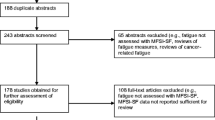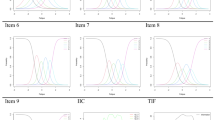Abstract
The fatigue impact scale (FIS) was developed previously as a symptom-specific profile measure of health-related quality of the (HRQoL) for use in medical conditions in which fatigue is a prominent chronic symptom. Thus, it was not developed to be a responsive measure of daily changes in fatigue. This study describes the development and initial validation of an adaptation of the FIS for daily use. Items for the daily fatigue impact scale (D-FIS) were selected from the pool of original FIS items through Rasch analyses of existing data. The reduced-item FIS was administered to a sample of 93 subjects with flu-like illness, 25 of whom were followed for a 21-day period. Rasch analyses were used to further reduce the scale to a minimum number of items that represented a unidimensional measure of self-reported fatigue impact. This 8-item D-FIS demonstrated good relations to flu symptom ratings and to other general health ratings. It also proved to be a responsive measure of change in reported fatigue impact for subjects who were followed longitudinally. This initial validation study indicates that the D-FIS has considerable promise as a valid measure of the subjective daily experience of fatigue.
Similar content being viewed by others
References
Kroenke K, Wood DR, Mangelsdorff DA, Meirer NJ, Powell JB. Chronic fatigue in primary care: Prevalence, patient characteristics, and outcome. J Am Med Assoc 1988; 260: 929-934.
Cathebras PJ, Robbins JM, Kirmayer LJ, Hayton BC. Fatigue in primary care: Prevalence, psychiatric comorbidity, illness behavior and outcome. J Gen Int Med, 1992; 7: 276-286.
Sandroni P, Walker C, Starr A. Fatigue in patients with multiple sclerosis: Motor pathway conduction and event-related potentials. Arch Neurol 1992; 49: 517-524.
Kent-Braun JA, Sharma KR, Weiner MW, Massie B, Miller RG. Central basis of muscle fatigue in chronic fatigue syndrome. Neurology 1993; 43: 125-131.
Piper BF, Fatigue. In: Carrieri-Kohlman V, Lindsey, AM, West CM. (eds), Pathophysiological Phenomena in Nursing: Human Responses to Illness, 2nd ed. Toronto: W.B. Saunders Company, 1993.
McNair D, Lorr M, Droppleman L. EDITS manual for the Profile of Mood States. San Diego: Educational and Industrial Testing Service, 1971.
Martin S. Is everyone as tired as I am? The CMA's physician survey results, 1999. The Can Med Assoc J 1999; 161: 1020-1021.
Bergner M, Babbitt RA, Pollard WE. The sickness impact profile: Reliability of a health status measure. Med Care 1976; 14: 146-155.
Hays RD. RAND-36 Health Status Inventory. San Antonio: The Psychological Corporation, 1998.
Guyatt GH, Van Zanten SJOV, Feeney DH, Patrick DL. Measuring quality of life in clincal trials: A taxonomy and review. Can Med Assoc J 1989; 140: 1441-1448.
Barofsky I, Legro MW. Definition and measurement of fatigue. Rev Infect Dis 1991; 13(Suppl 1): S94-S97.
Krupp LB, Larocca NG, Muir-Nash J, Steinberg AD. The Fatigue Severity Scale: Application to patients with multiple sclerosis and systemic lupus erythematosus. Arch Neurol, 1989; 46: 1121-1123.
Fisk JD, Ritvo PG, Ross L, Haase DA, Marrie TJ, Schlech WF. Measuring the functional impact of fatigue: Initial validation of the Fatigue Impact Scale. Clin Infect Dis 1994a; 18(Suppl. 1): S79-S83.
May J, Kline P. Problems in using an adjective checklist to measure fatigue. Pers Indivi Diff 1988; 9: 831-832.
Monks J. Experiencing symptoms in chronic illness: fatigue in multiple sclerosis. Arch Phys Med Rehabil, 1989; 11:78-83.
Streeten DHP, Thomas D, Bell DS. The roles of orthostatic hypotenstion, orthostatic tachycardia, and subnormal erythrocyte volume in the pathogenisis of the chronic fatigue syndrome. The Am J Med Sci 2000; 320: 1-8.
Fisk JD, Pontefract A, Ritvo PG, Archibald CJ, Murray TJ. The impact of fatigue in patients with multiple sclerosis. The Can J Neurolog Sci, 1994b; 21: 9-14.
Ritvo PG, Fisk JD, Archibald CJ, Murray TJ, Field C. Psychosocial and neurological predictors of mental health in multiple sclerosis patients. J Clin Epidemiol 1996; 49: 467-472.
Wagenaar H. An exploratory descriptive study of fatigue in women with systemic lupus erythematosus. Unpublished Masters Thesis, 1995, Department of Nursing, Dalhousie University.
LaChapelle DL, Finlayson MA. An evaluation of subjective and objective measures of fatigue in patients with brain injury and health controls. Brain Injury 1998; 12: 649-659.
Ingles JL, Eskes GA, Phillips SJ. Fatigue after stroke. Arch Phys Med Rehabi, 1999; 80: 173-178.
Goh J, Couglan B, Quinn J, O'Keane JC, Crowe J. Fatigue does not correlate with the degree of hepatitis or the presence of autoimmune disorders in chronic hepatitis C infection. Eur J Gastroenterol Hepatol, 1999; 11: 833-838.
Huet P-M, Deslauriers J, Tran A, Faucher C, Charbonneau J. Impact of fatigue on the quality of life of patients with primary biliary cirrhosis. Am J Gastroenterol 2000; 95: 760-767.
Prince MI, James OFW, Holland NP, Jones DEJ. Validation of a fatigue impact score in primary biliary cirrhosis: towards a standard for clinical and trial use. J Hepatol 2000; 32: 368-373.
Hayden FG, Treanor JJ, Fritz RS, et al. Use of the oral neuraminidase inhibitor Oseltamivir in experimental human influenza. J Am Med Assoc, 1999; 282: 1240-1246.
Hayden FG, Atmar RL, Schilling M, et al. Use of the selective oral neuraminidase inhibitor oseltamivir to prevent influenza. New Eng J Med, 1999; 341: 1336-1343.
Linacre JM, Wright, BD. A user's guide to BIGSTEPS: Rasch-model computer program (version 2.4). Chicago: MESA Press, 1994.
Prieto L, Lamarca R, Alonso J, Wright BD. Rasch measurement for reducing the items of the Nottingham Health Profile. J Outcome Meas, 1998; 2: 285-301.
Doble SE, Fisher AG. The dimensionality and validity of the Older Americans Resources and Services (OARS) Activities of Daily Living (ADL) Scale. J Outcome Meas 1998; 2: 4-24.
Linn RT, Blair RS, Granger CV, Harper DW, O'Hara PA Maciura E. Does the Functional Assessment Measure (FAM) extend the Functional Independence Measure (FIM1m) Instrument? A Rasch analysis of stroke inpatients. J Outcome Meas 1994; 3: 339-359.
Oakley F, Lai J-S, Sunderland T. A validation study of the Daily Activities Questionnaire: An activities of daily living assessment for people with Alzheimer's disease. J Outcome Meas 1999; 3: 297-307.
Wright BD, Stone MH. Best Test Design, Chicago: MESA Press, 1979.
Wright BD, Masters GN. Rating Scale Analysis, Chicago: MESA Press, 1982.
Wright B, Linacre M. Reasonable mean-square fit values. Rasch Meas Trans, 1994; 8: 370.
Rose SM, Fisk JD, Reimer MA, McGuinness S, Murray TJ, Metz LM. Age and sex differences in health related quality of life in patients with multiple sclerosis. Multiple Scler 1999; 5(suppl. 1): 49.
Nicholson KG, Aoki FY, Osterhaus ADM, et al. On behalf of the Neuraminidase Inhibitor Flu Treatment Investigator Group. Efficacy and safety of oseltamivir in treatment of acute influenza: A randomized controlled trial. The Lancet, 2000, 355: 1845-1850.
Treanor JJ, Hayden FG, Vrooman PS, et al. Efficacy and safety of the oral neuraminidase inhibitor oseltamivir in treating acute influenza: A randomized controlled trial. J Am Med Assoc 2000; 283: 1016-1024.
Wright B, Linacre M. Observations are always ordinal; measurements, however, must be interval. Arch Phys Med Rehabil 1989; 70: 857-860.
The Canadian MS Research Group A randomized controlled trial of Amantadine in fatigue associated with multiple sclerosis. The Can J Neurolog Sci 1987; 14: 273-278.
Canadian Coordinating Office for Health Technology Assessment. Guidelines for economic evaluation of pharmaceuticals: Canada 1st ed., Ottawa: CCOHTA, Ottawa 1994.
Author information
Authors and Affiliations
Rights and permissions
About this article
Cite this article
Fisk, J.D., Doble, S.E. Construction and validation of a fatigue impact scale for daily administration (D-FIS). Qual Life Res 11, 263–272 (2002). https://doi.org/10.1023/A:1015295106602
Issue Date:
DOI: https://doi.org/10.1023/A:1015295106602




